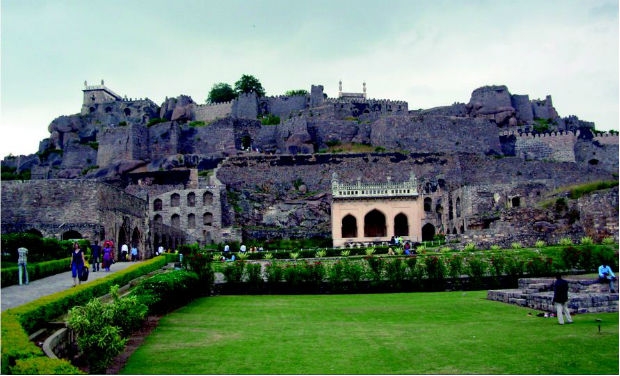I have been fortunate to view the Golconda Fort from close quarters since the early 1950s, as my maternal grandm o t h e r Amena Khatoon was the sister of the last qiledaar (commander-in-chief) of the fort. This is a hereditary post, and the last qiledaar was the grandson of Sir Afsarul Mulk, commanderin-chief of the Hyderabad Army .
My nani (maternal grandmother) was born in the qiledaar’s palace and was married there to my grandfather , Mustafa Baig, in the 1920s. My grandfather used to tell me stories about how the gates of the fort would be locked from inside at midnight in a ceremonial manner and the key would be delivered to the qiledaar’s palace. Every morning at 5 am, the key would be handed back for the fort gates to be opened.
I spent my childhood playing inside the fort and clapping at the entrance, as they would in the past when it acted as a wire less system. The clapping could be heard up at Balahisar, the seat of the king where he would be alerted via code. If you moved two feet away from the particular point at the entrance or from the top at Balahisar, you could not hear the signal, which was audible only to the king’s ears so he knew if anyone was coming to see him.
The huge baobab tree at the Nayaqila was one of our favourite haunts and we played hide-and seek there. Legend has it that a gang of robbers would attack the residents of the fort every night and no one could trace them as the doors of the fort were locked at night and when they were opened in the morning, the people going out were checked by the guards. It was later discovered that the gang of robbers hid in the baobab tree during the day and raided the fort at night. When they were caught, they were found cooking, eating, and sleeping inside the tree.
The old residents would point out the spots on the inside wall of the fort that were hit by Aurangazeb’s cannonballs when he fought a pitched battle with the Qutub Shahi kings to conquer the fort.
Most of the cannons housed at the fort have disappeared over time. The families who lived at Golconda Fort were mainly the soldiers’ families who had settled there. It was always quiet and peaceful after sun down. The influx of population, which has occupied every inch of the fort including the walls where kitchens and toilets have also been constructed, is a matter of shame for us. You can see rampant destruction and defacing of the fort walls.
The best thing that could have happened to Nayaqila is the allotment of land for the golf course, which is taking care of the property and treating it as a heritage monument rather than a golf course per se.
The writer is the president of Hyderabad Golf Course and grandson of the last qiledaar of Golconda Fort.
source: http://www.DeccanChronicle.com / Home> Lifestyle> Travel / by DC, Asadullah Pasha / January 06th, 2013
